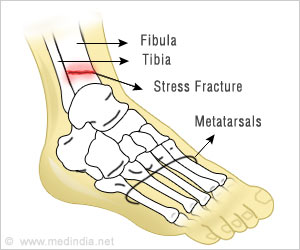Jumping up and down repeatedly, running long distances, or wearing wrong or worn-out footwear can cause a stress fracture. If left unattended, the pain at the site of stress fracture and around it may increase and increase the risk of suffering a complete fracture in the affected bone.
‘Rest, Ice, Compression and Elevation could help to alleviate stress fractures.’
Middle-aged people, who have not indulged in outdoor activities ever but started after lockdown was lifted, comprise 10 per cent of such patients in the past one year, said doctors at the Indian Spinal Injuries Centre (ISIC).
“Most of the patients belong to the age group of 30-40 years, followed by 40-50 years. Upon investigation, most of these people were found to have never done rigorous exercises such as running, skipping, sports or jumping.
However, with the discussion around health, immunity and fitness raging due to the pandemic, they chose to become active, which was a shock for their body that is both unaccustomed and unconditioned for such activities,” said Maninder Shah Singh, Senior Consultant Orthopedics and Chief of Foot and Ankle Service, at ISIC.
The injury begins with repetitive and excessive stress on the bone which can result in acceleration of normal bone remodeling, the production of micro fractures, the creation of a bone stress injury (that is, stress reaction), and, eventually, a stress fracture, Singh said.
With the COVID-19 pandemic creating a havoc around the world, exercise was emphasized as a key pillar to maintain physical and mental health. Many people, thus, took up running, aerobics, and other exercises to keep themselves fit and healthy.
But being unaccustomed to physical training and the sudden change in lifestyle, reduced exposure to sunlight which affected bone health due to low Vitamin D levels also increased the risk for stress fractures, said Dr Aashish Chaudhry, Managing Director and Head – Orthopedics and Joint Replacement dept, Aakash Healthcare, Dwarka.
“Stress fractures can result from increasing the intensity of an activity too quickly. When the bones are weak and subjected to unaccustomed force without enough time for recovery, it makes them susceptible to stress fractures,” he added.
Another reason is that people are working at home without proper guidance, the experts noted.
“The primary reason for such a fracture is people are doing an activity which earlier they were not used to and they are not using proper equipment or care to do the activity. Beside this we are also seeing sports injuries and they have definitely doubled.
And the reason is people want to do more activities, people are working out at home more without proper equipment and guidance, which leads to injuries in their joints and ligaments,” said Dr Subhash Jangid, Director and Unit Head, Bone and Joint Institute, Fortis Memorial Research Institute, Gurugram.
The doctors advise RICE treatment — Rest, Ice, Compression and Elevation — as first-aid. They also recommend complete rest for six weeks.
Source: IANS



